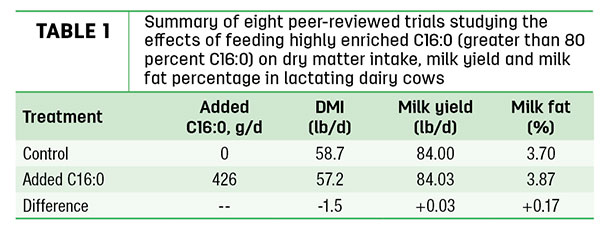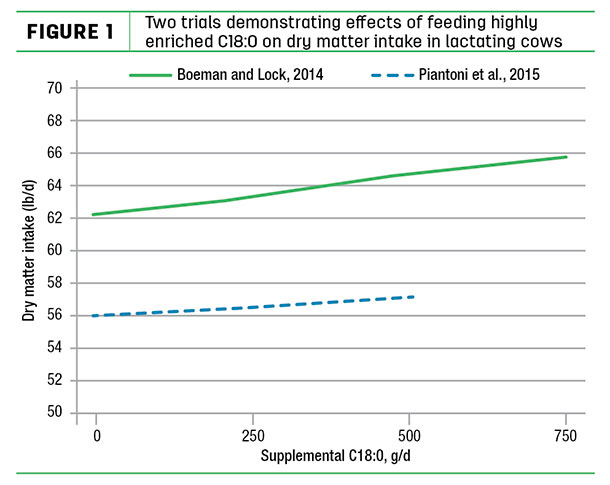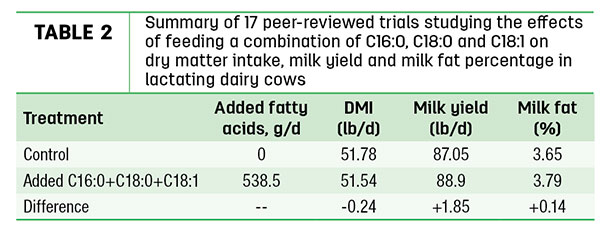Over the last few decades, numerous advances in the dairy industry have allowed lactating dairy cows to produce greater quantities of higher-quality milk than ever before.
In 1980, researchers reported that improved genetic potential for milk and component yield will require an ever-increasing amount of energy in diets to meet lactation, reproduction and growth requirements of the cow.
Forages are typically lower in energy content than grains, and grain feeding rates in diets are limited as excesses can cause acidosis, poor rumen health and lead to loss of both milk and milkfat yield.
Fat supplementation to diets offers the greatest potential to help meet energy requirements of the cow, but recent research has shown fatty acids which make up the fat are involved in many functions and can elicit metabolic responses beyond being a source of energy.
British dairy scientists in the late 1960s were among the first to look at the effects of feeding specific fatty acids rather than just “fat” on lactation performance. They found responses in yields of milk and milkfat, and the composition of milk fat varied with the fatty acid and amount of the fatty acid fed.
Since this initial research, many research studies have been conducted on individual and blends of free fatty acids to define their roles in metabolism and achieve optimum lactation performance.
The saturated fatty acids palmitic (C16:0) and stearic (C18:0) and the monounsaturated fatty acid oleic (C18:1) have become especially popular due to claims of strong improvements to milk and fat yields.
More recent research has shown individual fatty acids have unique specific effects on dry matter intake (DMI), milk yield and milkfat yield, and that feeding a combination of fatty acids rather than a single fatty acid may optimize lactation performance.
Milkfat generally contains 27 percent short-chain fatty acids (4 to 14 carbons in length), 33 percent C16 fatty acids and 40 percent C18 fatty acids, but specific composition will vary due to dietary manipulation. The short chain and some C16:0 in milk are synthesized within the mammary gland (de novo synthesis) from rumen-volatile fatty acids, acetate and butyrate.
Fatty acids with 18 carbons or longer and some C16:0 pass into the mammary gland as preformed fatty acids originating from the diet. Thus, C16:0 in milk comes from both de novo synthesis and transfer from the diet. During periods of negative energy balance, adipose tissue also can be a source of preformed fatty acids entering the mammary gland, but this represents only about 12 percent of milk fatty acids.
Feeding fat supplements rich in C16:0 (85+ percent C16:0) have been shown to increase milkfat percentage. A summary of eight recent peer-reviewed trials with similar C16:0 feeding amounts (Table 1) showed supplementing C16:0 results in a 0.17 percent unit increase in milkfat percentage but lowered DMI an average of 1.5 pounds per cow per day.

Milk yield was unaffected by C16:0 supplementation. A recent 12-study meta-analysis presented at the ADSA/ASAS joint annual meeting also showed supplementing C16:0 increased milkfat percentage (0.23 percent) but did not increase milk yield.
Considerably fewer studies have been done feeding only C18:0 as the fat supplement. A study in 2015 feeding a C18:0 supplement to high-producing dairy cows found increases in DMI, milk yield and milkfat yield compared to cows fed no supplemental fat. Stearic acid did not increase milkfat percentage, but milkfat yield increased as a result of increased milk yield.
Researchers in 2014 fed an 87 percent C18:0 supplement and found DMI increased with increasing C18:0 intake (230 to over 700 grams per day), but milk and milkfat yield were unaffected with supplementation. The results of stearic acid on DMI are illustrated in Figure 1.

Results from the individual fatty acid supplement studies show C16:0 and C18:0 differ in their effects on metabolism and lactation performance. Palmitic acid increases milkfat percentage, whereas C18:0 response is increased DMI and milk yield. The effects on DMI differ with C16:0 and similarly with C18:1, lowering DMI compared to increase or no change in DMI with C18:0 supplementation.
Supplements consisting primarily of C16:0 and C18:1 appear to increase a gut hormone (cholecystokinin) that regulates gastric emptying and induces satiety, lowering DMI in mammalian species. Stearic acid does not appear to increase cholecystokinin and even negates the effects of C16:0 and C18:1 on lowering DMI when fed in a supplement with these acids.
In two recent trials, feeding highly purified C18:0 (98 percent) to lactating cows significantly increased DMI when fed at 230 to over 700 grams per day.
The lactating cow appears to have evolved with C18:0 metabolism in mind. The typical lactation diet includes approximately 20 to 50 grams per day of C18:0, while C18:0 appears in the duodenum in excess of 500 grams per day.
The discrepancy in the quantity of C18:0 fed compared with that found in the duodenum is due to biohydrogenation of unsaturated 18-carbon fatty acids in the rumen. In a healthy rumen, greater than 70 percent of unprotected, unsaturated 18-plus carbon fatty acids are biohydrogenated to C18:0.
If C18:0 delivery in such quantities to the duodenum was problematic to DMI, the energy required for production and reproduction would be compromised due to reduced feed intake.
More research is needed to determine the differential effects of specific fatty acids on DMI and why C18:0 addition to a mixture of primarily C16:0 and C18:1 appears to mitigate the negative effects of C16:0 and C18:1.
Results from the studies with feeding only C16:0 or C18:0 show they have different but somewhat complementary effects on lactation performance. Therefore, feeding a blend or combination of fatty acids as the supplemental fat source should provide maximum lactation performance benefits.
A summary of 17 peer-reviewed trials has demonstrated that feeding a blend of C18:0, C16:0 and C18:1 results in improvements to both milk yield and milkfat percentage with only a minimal decrease in DMI (Table 2).
 Supplementing the blended product resulted in an increase in milkfat percentage similar to that observed when feeding C16:0 fat supplements (0.14 percent) while also improving milk yield by 1.85 pounds per cow per day. A greater income over feed cost can be achieved when both milk yield and milkfat percentage are simultaneously improved.
Supplementing the blended product resulted in an increase in milkfat percentage similar to that observed when feeding C16:0 fat supplements (0.14 percent) while also improving milk yield by 1.85 pounds per cow per day. A greater income over feed cost can be achieved when both milk yield and milkfat percentage are simultaneously improved.
In summary, research regarding the proper balance of fatty acid supplementation to lactating cows is in its infancy. Increasing the energy density of the diet with fatty acid supplementation has been reported to improve milk yield, milk components and reproductive efficiency.
Future research efforts should focus on determining how to supplement cows with mixtures of fatty acids that improve milk yield, milk components and reproductive efficiency without negatively affecting DMI, ultimately increasing income over feed cost to ensure today’s dairyman a solid economic return on the fatty acid supplement dollar.








